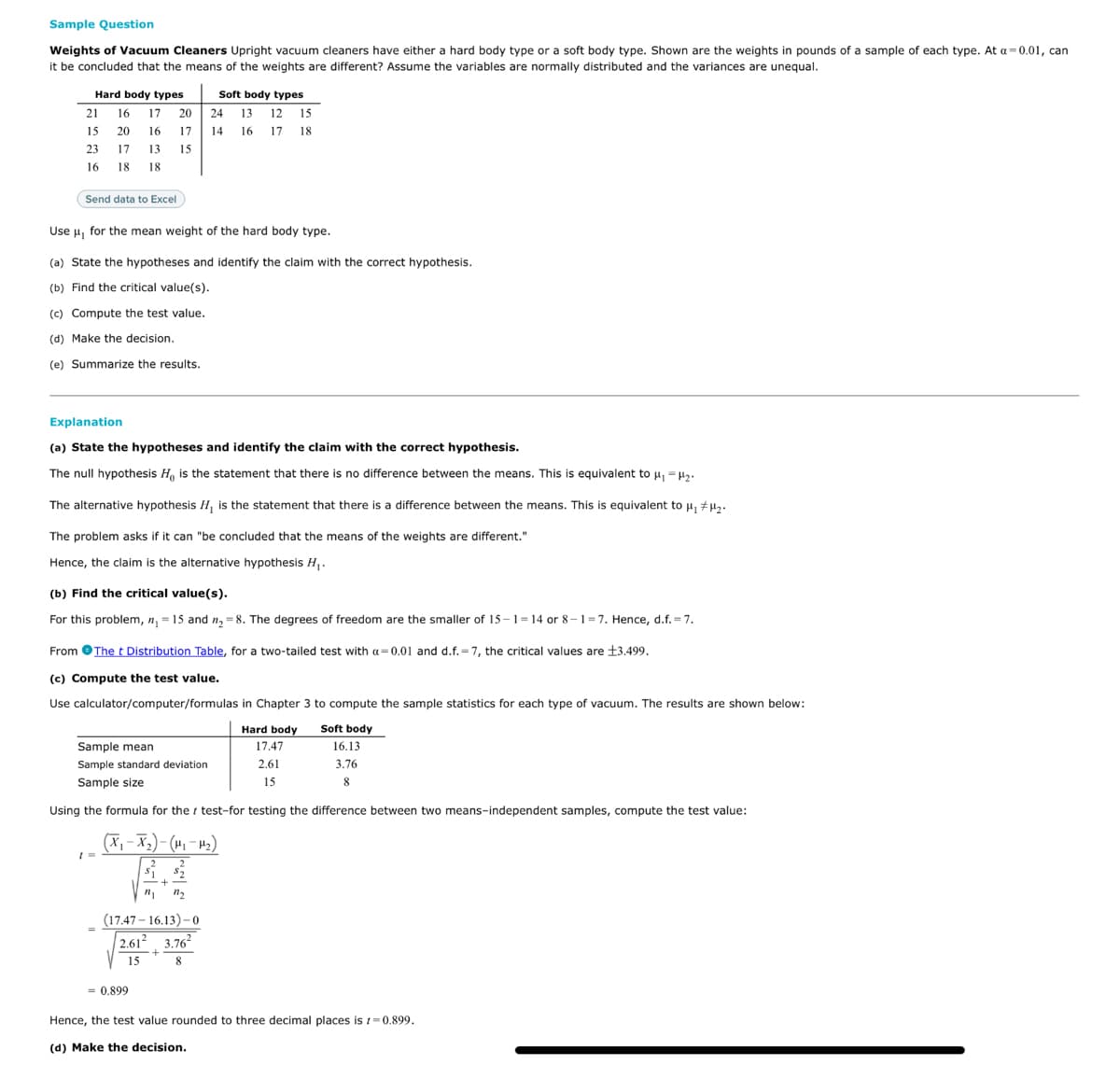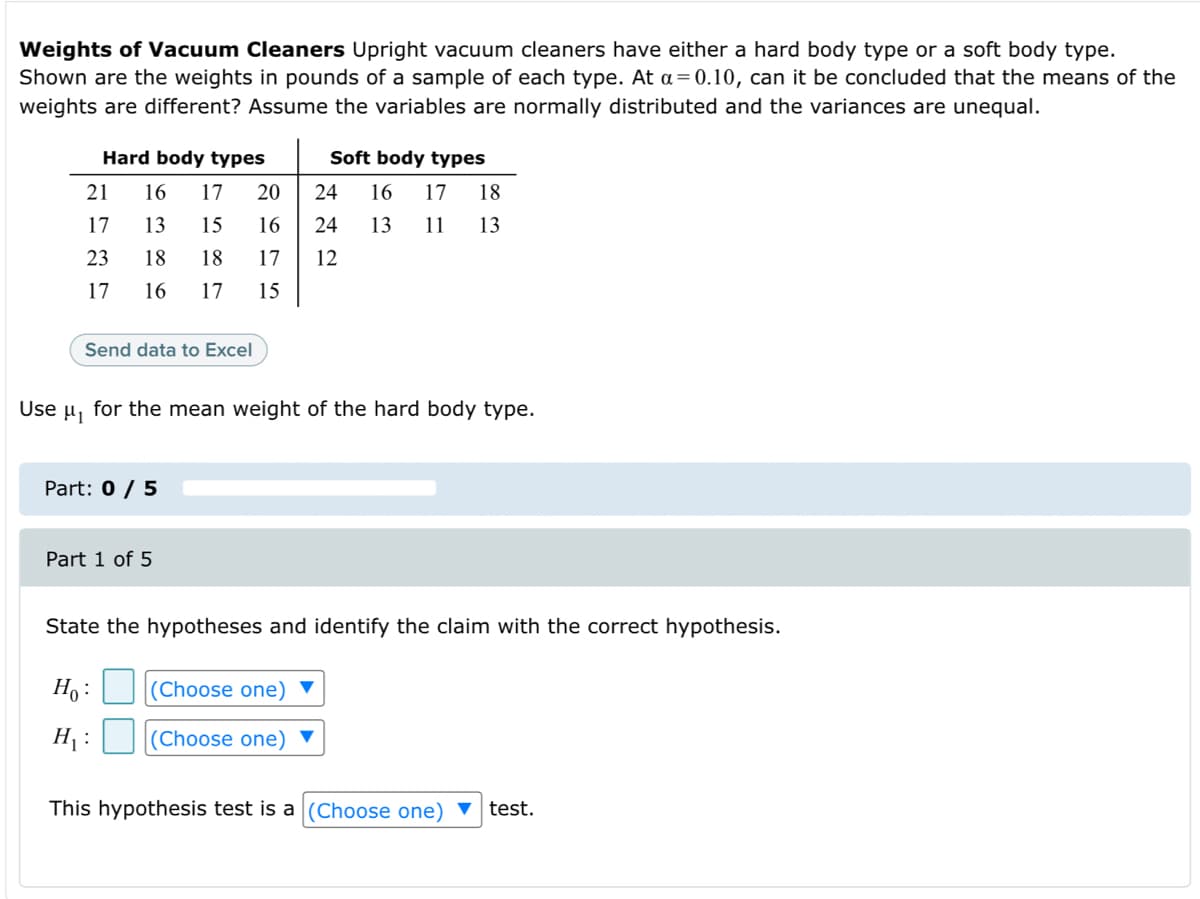Sample Question Weights of Vacuum Cleaners Upright vacuum cleaners have either a hard body type or a soft body type. Shown are the weights in pounds of a sample of each type. At a= 0.01, can it be concluded that the means of the weights are different? Assume the variables are normally distributed and the variances are unequal. Hard body types Soft body types 21 16 17 20 24 13 12 15 15 20 16 17 14 16 17 18 23 17 13 15 16 18 18 Send data to Excel Use µ, for the mean weight of the hard body type. (a) State the hypotheses and identify the claim with the correct hypothesis. (b) Find the critical value(s). (c) Compute the test value. (d) Make the decision. (e) Summarize the results. Explanation (a) State the hypotheses and identify the claim with the correct hypothesis. The null hypothesis H, is the statement that there is no difference between the means. This is equivalent to u, =H,. The alternative hypothesis H, is the statement that there is a difference between the means. This is equivalent to H, #µ,. The problem asks if it can "be concluded that the means of the weights are different." Hence, the claim is the alternative hypothesis H. (b) Find the critical value(s). For this problem, n, = 15 and n, = 8. The degrees of freedom are the smaller of 15-1=14 or 8-1=7. Hence, d.f.= 7. From OThe t Distribution Table, for a two-tailed test with a=0.01 and d.f. = 7, the critical values are 13.499. (c) Compute the test value. Use calculator/computer/formulas in Chapter 3 to compute the sample statistics for each type of vacuum. The results are shown below: Hard body Soft body Sample mean 17.47 16.13 Sample standard deviation 2.61 3.76 Sample size 15 8 Using the formula for the i test-for testing the difference between two means-independent samples, compute the test value: ("t – \n1) – (*x – 'x) (17.47 - 16.13)-0 2.612 3.76? 15 8. = 0,899 0 000
Sample Question Weights of Vacuum Cleaners Upright vacuum cleaners have either a hard body type or a soft body type. Shown are the weights in pounds of a sample of each type. At a= 0.01, can it be concluded that the means of the weights are different? Assume the variables are normally distributed and the variances are unequal. Hard body types Soft body types 21 16 17 20 24 13 12 15 15 20 16 17 14 16 17 18 23 17 13 15 16 18 18 Send data to Excel Use µ, for the mean weight of the hard body type. (a) State the hypotheses and identify the claim with the correct hypothesis. (b) Find the critical value(s). (c) Compute the test value. (d) Make the decision. (e) Summarize the results. Explanation (a) State the hypotheses and identify the claim with the correct hypothesis. The null hypothesis H, is the statement that there is no difference between the means. This is equivalent to u, =H,. The alternative hypothesis H, is the statement that there is a difference between the means. This is equivalent to H, #µ,. The problem asks if it can "be concluded that the means of the weights are different." Hence, the claim is the alternative hypothesis H. (b) Find the critical value(s). For this problem, n, = 15 and n, = 8. The degrees of freedom are the smaller of 15-1=14 or 8-1=7. Hence, d.f.= 7. From OThe t Distribution Table, for a two-tailed test with a=0.01 and d.f. = 7, the critical values are 13.499. (c) Compute the test value. Use calculator/computer/formulas in Chapter 3 to compute the sample statistics for each type of vacuum. The results are shown below: Hard body Soft body Sample mean 17.47 16.13 Sample standard deviation 2.61 3.76 Sample size 15 8 Using the formula for the i test-for testing the difference between two means-independent samples, compute the test value: ("t – \n1) – (*x – 'x) (17.47 - 16.13)-0 2.612 3.76? 15 8. = 0,899 0 000
MATLAB: An Introduction with Applications
6th Edition
ISBN:9781119256830
Author:Amos Gilat
Publisher:Amos Gilat
Chapter1: Starting With Matlab
Section: Chapter Questions
Problem 1P
Related questions
Question
100%
The first pic is the question. Since some tutors have been solving the problems wrong recently (no judgment), I’ve added a sample question to solve problem.

Transcribed Image Text:Sample Question
Weights of Vacuum Cleaners Upright vacuum cleaners have either a hard body type or a soft body type. Shown are the weights in pounds of a sample of each type. At a= 0.01, can
it be concluded that the means of the weights are different? Assume the variables are normally distributed and the variances are unequal.
Hard body types
Soft body types
21 16
15 20
20 24 13 12 15
17
16
17
14 16 17 18
23
17
13
15
16
18
18
Send data to Excel
Use u, for the mean weight of the hard body type.
(a) State the hypotheses and identify the claim with the correct hypothesis.
(b) Find the critical value(s).
(c) Compute the test value.
(d) Make the decision.
(e) Summarize the results.
Explanation
(a) State the hypotheses and identify the claim with the correct hypothesis.
The null hypothesis H, is the statement that there is no difference between the means. This is equivalent to u, =H,.
The alternative hypothesis H, is the statement that there is a difference between the means. This is equivalent to H, #µ,.
The problem asks if it can "be concluded that the means of the weights are different."
Hence, the claim is the alternative hypothesis H.
(b) Find the critical value(s).
For this problem, n, = 15 and n, = 8. The degrees of freedom are the smaller of 15–1=14 or 8-1=7. Hence, d.f. =7.
From OThe t Distribution Table, for a two-tailed test with a=0.01 and d.f. =7, the critical values are £3.499.
(c) Compute the test value.
Use calculator/computer/formulas in Chapter 3 to compute the sample statistics for each type of vacuum. The results are shown below:
Hard body
Soft body
Sample mean
17.47
16.13
Sample standard deviation
2.61
3.76
Sample size
15
8
Using the formula for the i test-for testing the difference between two means-independent samples, compute the test value:
(*t – \n) – (*x – 'x)
(17.47 – 16.13) –0
2.612 3.76?
15
8.
= 0.899
Hence, the test value rounded to three decimal places is t = 0.899.
(d) Make the decision.

Transcribed Image Text:Weights of Vacuum Cleaners Upright vacuum cleaners have either a hard body type or a soft body type.
Shown are the weights in pounds of a sample of each type. At a=0.10, can it be concluded that the means of the
weights are different? Assume the variables are normally distributed and the variances are unequal.
Hard body types
Soft body types
21
16
17
20
24
16
17
18
17
13
15
16
24
13
11
13
23
18
18
17
12
17
16
17
15
Send data to Excel
Use u, for the mean weight of the hard body type.
Part: 0 / 5
Part 1 of 5
State the hypotheses and identify the claim with the correct hypothesis.
Ho :
(Choose one) ▼
H :
(Choose one) ▼
This hypothesis test is a (Choose one) ▼ test.
Expert Solution
This question has been solved!
Explore an expertly crafted, step-by-step solution for a thorough understanding of key concepts.
This is a popular solution!
Trending now
This is a popular solution!
Step by step
Solved in 7 steps with 4 images

Recommended textbooks for you

MATLAB: An Introduction with Applications
Statistics
ISBN:
9781119256830
Author:
Amos Gilat
Publisher:
John Wiley & Sons Inc

Probability and Statistics for Engineering and th…
Statistics
ISBN:
9781305251809
Author:
Jay L. Devore
Publisher:
Cengage Learning

Statistics for The Behavioral Sciences (MindTap C…
Statistics
ISBN:
9781305504912
Author:
Frederick J Gravetter, Larry B. Wallnau
Publisher:
Cengage Learning

MATLAB: An Introduction with Applications
Statistics
ISBN:
9781119256830
Author:
Amos Gilat
Publisher:
John Wiley & Sons Inc

Probability and Statistics for Engineering and th…
Statistics
ISBN:
9781305251809
Author:
Jay L. Devore
Publisher:
Cengage Learning

Statistics for The Behavioral Sciences (MindTap C…
Statistics
ISBN:
9781305504912
Author:
Frederick J Gravetter, Larry B. Wallnau
Publisher:
Cengage Learning

Elementary Statistics: Picturing the World (7th E…
Statistics
ISBN:
9780134683416
Author:
Ron Larson, Betsy Farber
Publisher:
PEARSON

The Basic Practice of Statistics
Statistics
ISBN:
9781319042578
Author:
David S. Moore, William I. Notz, Michael A. Fligner
Publisher:
W. H. Freeman

Introduction to the Practice of Statistics
Statistics
ISBN:
9781319013387
Author:
David S. Moore, George P. McCabe, Bruce A. Craig
Publisher:
W. H. Freeman